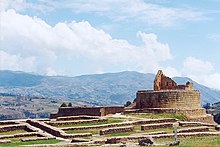Cañar Province
|
||
|---|---|---|
| flag | ||

|
||
| Location in Ecuador | ||
| Basic data | ||
| Capital | Azogues | |
| population | 221.045 (2005,) | |
| - Share in Ecuador | 1.7% | |
| - Rank in Ecuador | Rank 13 of 22 | |
| - density | 57 inhabitants per km² | |
| surface | 3,908 km² | |
| - Share in Ecuador | 1.5% | |
| - Rank in Ecuador | Rank 19 out of 22 | |
| License Plate | U | |
| Set up | 1880 | |
| prefect | Santiago Correa ( PAIS ) | |
| governor | Luis Quishpi Velez | |
| Seats in the National Congress |
3 out of 100 | |
| structure | 7 cantons | |
| ISO 3166-2 | EC-F | |
| www.hcpcanar.gov.ec ( Memento from August 14, 2006 in the Internet Archive ) | ||
The province of Cañar ( Spanish Provincia del Cañar ) is a province in Ecuador . It is located in the Andes and has around 215,000 inhabitants (2003) on an area of 3,908 km². The name of the province goes back to the Kañari people . Its capital is Azogues , another important city is Cañar . The well-known ruins of the Inca fortress and cult site Ingapirca are in the province .
location
The province of Cañar is located in the southern center of Ecuador and borders in the north on the province of Chimborazo , in the east on the province Morona Santiago , in the south on the province Azuay and in the west on the province Guayas .
politics
The directly elected prefect of Cañar is called Santiago Correa and belongs to the Ecuadorian ruling party Alianza PAIS . The mayor of the capital Azogues is a member of the opposition party Movimiento CREO . Four of the other six mayors of cantonal capitals represent the Pachakutik party .
The governor appointed by the President of Ecuador is Luis Quishpi Vélez.
history
The province of Cañar was established during the presidency of Ignacio de Veintemilla at the request of the canton of Azogues by resolution of the Ecuadorian Congress of November 17, 1880 as the province of Azogues. It originally comprised the cantons of Azogues and Cañar, which were previously part of Azuay, and the parish of Deleg.
The province was later renamed Cañar in homage to the Kañari indigenous people . The historical and current main settlement area of the Kañari lies in the province.
Attractions
In addition to the mountain region (including parts of the Sangay National Park ) and numerous lakes, the ruins of Ingapirca are the main attractions of the province. At the same time, the Ingapirca complex is the most important pre-Columbian archaeological site in Ecuador. It is located about 50 km north of Azogues in the parish of Ingapirca in the canton of Cañar.
The exact purpose of the complex, which the Spanish chroniclers of the conquest called a “castle” ( castillo ), has still not been deciphered. In the meantime, however, it has become clear that it was not only a fortress, but also a place of worship of the Inca or Kañari. The construction of the jointless joining of large hewn stone blocks is similar to the Inca ruins preserved in Cuzco . According to current interpretation, the complex includes a sun temple , an observatory for observing the sun and moon , storage rooms, ritual baths, tombs, streets and squares. The name "Ingapirca" comes from Quechua and means "Wall of the Inca".
The Laguna de Culebrillas is located near Ingapirca at the foot of Mount Yanaurco at 3915 meters above sea level . It is still under discussion whether the lake fed by the river of the same name was created naturally or was artificially created by the Kañari hundreds of years ago.
Cantons
The Cañar Province currently comprises seven cantons . These are (in order of their establishment):
- Cañar (established in 1824 as a canton of the Greater Colombian province of Cuenca (today Azuay), capital: Cañar )
- Azogues (established in 1825 as a canton of the Greater Colombian province of Cuenca, capital: Azogues )
- Biblián (established in 1944, capital: Biblián )
- La Troncal (established in 1983, capital: La Troncal , formerly Rircay among the Kañari)
- El Tambo (established in 1991, capital: El Tambo )
- Déleg (established in 1992, capital: Déleg )
- Suscal (established in 1996, capital: Suscal ; Abelina Morocho Pinguil, a teacher of the Kañari ethnic group, who has been in office since the canton was established, was the first indigenous mayor of Ecuador at the time)
Remarks
- ^ INEC, Población total y tasa brutas de natalidad, mortalidad general, mortalidad infantil y materna según regiones y provincias de residencia habitual, año 2005 ( Memento of January 30, 2006 in the Internet Archive ), accessed on October 13, 2007.
Web links
- Page of the provincial government ( memento of August 14, 2006 in the Internet Archive ) with a lot of information (Spanish)
Coordinates: 2 ° 34 ′ S , 78 ° 59 ′ W


